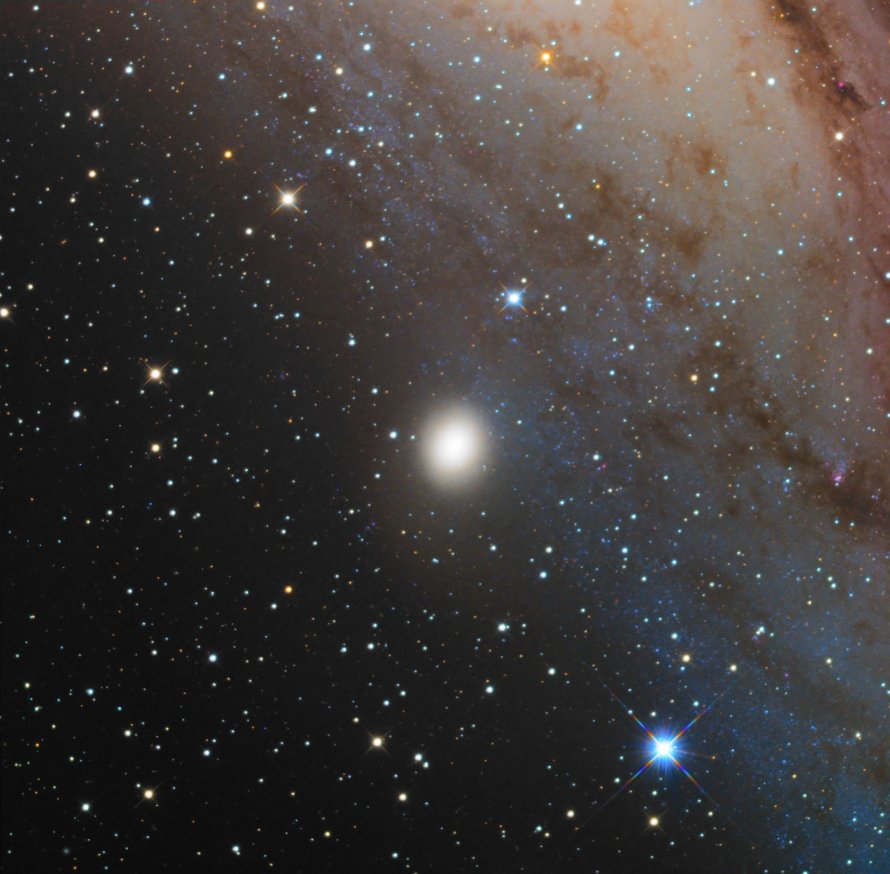M32 (NGC 221) - Le Gentil
Messier 32 (NGC 221), also known as the Le Gentil, is a dwarf elliptical galaxy located in the constellation Andromeda in the Local Group of galaxies. M32 is 2490000 light years away from Earth.
M32 is best viewed during winter, is magnitude 8.1, and can be viewed with binoculars. M32 is 8.7' x 6.5' in apparent size. For reference, the full moon is 30'.
Observing difficulty: Intermediate
- Name:
- Le Gentil
- Type:
- dwarf elliptical galaxy
- Constellation:
- Andromeda
- NGC or IC:
- NGC 221
- Magnitude:
- 8.1
- Viewing:
- binoculars
- Size:
- 8.7' x 6.5'
- Distance (light years):
- 2490000 LY
- RA:
- 0h 42.8m
- Dec:
- 40 52'
- Season:
- winter
- Galaxy group:
- Local Group
- Messier Marathon #:
- 5
* The naked eye can see up to magnitude ~7-8 objects under ideal dark sky conditions.
Messier 32: A Close Companion of Andromeda
Among the vast assortment of celestial objects in Charles Messier's famed catalog, one object of note is Messier 32 (M32). M32, one of the closest satellite galaxies to the Milky Way, is a particular object of intrigue, lying in close proximity to the much larger Andromeda Galaxy (M31). This article will explore the discovery, characteristics, and observation details of M32.
Discovery and Observation History
French astronomer Charles Messier first observed and recorded M32 in 1749, noting it as a companion to the larger Andromeda Galaxy. Messier's contemporary, German astronomer Johann Bode, independently discovered M32 in 1777. Due to its close proximity to M31 and its high surface brightness, it was observed and mistaken as a star by many early astronomers.
Physical Characteristics and Magnitude
M32 is a compact, dwarf elliptical galaxy located about 2.49 million light-years from Earth and situated in the constellation of Andromeda. It has an apparent magnitude of 8.1, making it observable with binoculars or a small telescope under dark sky conditions. With a diameter of about 8,000 light-years, M32 is significantly smaller than our own Milky Way galaxy, containing several billion stars, most of them old and metal-poor.
Astronomical Significance
The dwarf elliptical galaxy M32 has been of particular interest to astronomers due to its unique structure and close relationship with the Andromeda Galaxy. M32 is believed to have once been a larger spiral galaxy that was transformed into its current compact form due to tidal interactions with M31. This process stripped off its outer layers, leaving behind a dense, compact core. The galaxy is also unique in that it exhibits a strong central concentration of stars, unlike most dwarf elliptical galaxies.
Finding and Viewing M32
As a satellite of the Andromeda Galaxy, M32 can be found close to M31 in the sky. In fact, it appears as a faint glow in the southern part of M31 and can easily be spotted in the same field of view as its larger neighbor in a telescope. Given its magnitude of 8.1, a small telescope or binoculars under clear, dark skies should be sufficient to observe this intriguing dwarf galaxy. However, its relatively high surface brightness also makes it a good target for larger telescopes, which can reveal more of its structural details.



